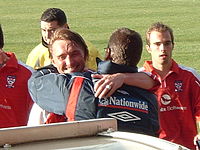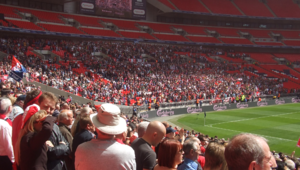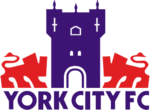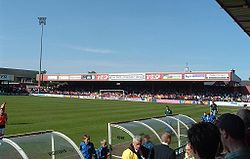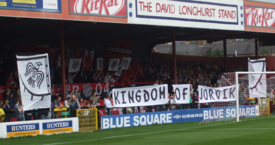- York City F.C.
-
York City 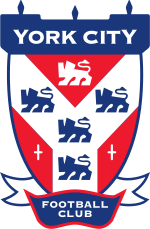
Full name York City Football Club Nickname(s) Minstermen, Founded 1922 Ground Bootham Crescent
York
(Capacity: 7,872[1])Chairman Jason McGill[2] Manager Gary Mills[3] League Conference National 2010–11 Conference National, 8th[4] Home coloursAway colours Current season
Current seasonYork City Football Club is an English football club based in York, North Yorkshire. The club participates in the Conference National, the fifth tier of English football. Founded in 1922, they joined the Football League in 1929, and have spent most of their history in the lower divisions. The club briefly rose as high as the second tier of English football, spending two seasons in the Second Division in the 1970s. At the end of the 2003–04 season the club lost their League status when they were relegated from the Third Division, and have since remained in the Conference.
York have enjoyed more success in cup competitions than in the league, with highlights including an FA Cup semi-final appearance in 1955. In the 1995–96 League Cup, York beat Manchester United 3–0 at Old Trafford; Manchester United went on to win the FA Premier League and FA Cup double that season. Also, in the FA Cup, they beat Arsenal, as well as holding Liverpool to a draw on two occasions. York made an appearance at Wembley Stadium in 1993, when they defeated Crewe Alexandra in the Third Division play-off Final. They reached the Final of the FA Trophy in 2009, but were defeated 2–0 by Stevenage Borough at the new Wembley Stadium. This was followed by a 3–1 defeat to Oxford United in the 2010 Conference National play-off Final.
York play their home games at Bootham Crescent in York. The stadium was known as KitKat Crescent as part of a sponsorship deal with Nestlé from 2005 to 2010.
Contents
History
For a statistical breakdown by season, see List of York City F.C. seasons.York City Football Club was first founded in 1908 as an amateur side,[5] although some sources state the roots of the club can be traced as far back as 1897 when the York and District League was formed.[6] The club joined the Northern League in 1908, but left after two seasons to form the Yorkshire Combination (a proto-Yorkshire League). The club turned professional in 1912 and joined the Midland League, where they played for three seasons, rising as high as tenth position. They played their final season in 1914–15 before folding in 1917 during the First World War.[7]
 York City squad of 1922
York City squad of 1922
The club was re-founded in 1922 by members of the former club. They founded a limited company and gained admission to the Midland League, where the team played in for seven seasons, achieving a highest finish of sixth, in both 1924–25 and 1926–27.[8][9] York were elected to play in the Football League in 1929, and spent the following 22 seasons in the Third Division North, from 1929–30 to 1957–58.[8] The club ended the majority of seasons in the bottom half of the table until the 1950s, when they reached fourth in both the 1952–53 and 1954–55 seasons.[8]
The club fared better in cup competitions and built a reputation for "giant killing",[10] the earliest example being in the 1937–38 season's FA Cup, when the team, then playing in the Third Division North, managed to knock out First Division West Bromwich Albion and Middlesbrough.[11] They met Huddersfield Town in the quarter-finals and drew 0–0, before losing the replay 2–1 at Leeds Road.[11] The club's longest cup run came when they reached the FA Cup semi-final in the 1954–55 season, a campaign in which Arthur Bottom scored eight goals, and the team eliminated a Blackpool side, featuring Stanley Matthews,[6] who had won the competition eighteen months earlier. In the semi-final, York drew 1–1 with Newcastle United, taking the tie to a replay, in which City were defeated 2–0.[12]
In 1958, York became founding members of the Fourth Division, as the Third Divisions North and South were restructured into new Third and Fourth divisions, based on league positions at the end of the 1957–58 season.[13] They missed out on the runner-up spot in the inaugural season only on goal average, and were promoted to the Third Division in third place, but were relegated back after just one season.[8] York's highest progression in the League Cup came in 1961–62, the competition's second season, after reaching the fifth round.[8] A second promotion in 1964–65, again in third place in the Fourth Division, saw another instant relegation back from the Third Division the next season.[8] York's record of promotion every six years was maintained by a team sporting the future England forward Phil Boyer in 1970–71,[8][14] and this time the team managed to stay in the Third Division, albeit only on goal average in both the next two seasons.[15]
After these two seasons the team hit form in the 1973–74 season, when "three up, three down" promotion and relegation was introduced to the Football League.[16] After being among the leaders all season York were eventually promoted to the Second Division in third place.[16] Their first season in the Second Division saw York finish in their highest ever league position, 15th place.[8] On 29 March 1975, they played in front of the highest ever League crowd to see them – 46,802 at Old Trafford in a 2–1 defeat to Manchester United.[17] The following season York finished in 21st place in the Second Division and were relegated back to the Third Division.[8] Under former Manchester United manager Wilf McGuinness, the club dropped further still, into the Fourth Division in the 1976–77 season after finishing bottom of the Third Division.[18] In the 1981–82 season, York failed to win in 12 home games, a club record, and lost to non-League side Altrincham in the FA Cup.[19]
York won the Fourth Division championship with 101 points in the 1983–84 season, becoming the first side to reach 100 points in a Football League season.[20] In January 1985, York recorded a victory over First Division Arsenal in the fourth round of the FA Cup after winning 1–0 at Bootham Crescent, courtesy of an 89th minute penalty kick scored by Keith Houchen.[21] York proceeded to draw 1–1 with Liverpool at Bootham Crescent on 16 February 1985, but lost 7–0 in the replay at Anfield; York's record cup defeat.[21] The teams met again the following season and after another 1–1 at Bootham Crescent, Liverpool won 3–1 in the replay after extra time at Anfield.[22]
In 1993 York ended a five-year spell in the Third Division by gaining promotion to the Second Division via the play-offs, beating Crewe Alexandra in a penalty shootout in the Final at Wembley Stadium.[8][23] York stayed in the Second Division for six seasons, during which they reached the play-offs in their first season, but lost to Stockport County in the semi-final.[8]
York recorded a shock victory in the 1995–96 League Cup second round when they beat the eventual FA Premier League and FA Cup double winners Manchester United 4–3 on aggregate, including a 3–0 win in the first leg at Old Trafford.[24] Although United had fielded five fringe players in the first leg, their full first team was unable to overcome the deficit at Bootham Crescent in front of a 9,386 crowd.[24] York then went on to beat Everton in the second round of the League Cup the following season in 1996.[25] They drew the first leg 1–1 at Goodison Park, but won the second leg 3–2 at Bootham Crescent.[25]
In December 2001, long-serving chairman Douglas Craig put the club and its ground up for sale for £4.5 million, announcing that unless a new owner was found before 1 April 2002, York would be withdrawn from the Football League.[26] Team B&Q racing driver and team owner John Batchelor took over as chairman in March 2002.[27] Batchelor promised the club he would purchase the ground, give the York City Supporters' Trust 24% of the shares and would invite two supporters onto the board, but after these promises all went undelivered,[28] the Supporters’ Trust took control of the club in 2003.[29]
York failed to win any of their final 20 league fixtures in the 2003–04 season and were relegated to the Football Conference after 75 years of League membership.[30] This was followed by the sacking of manager Chris Brass in November 2004 and, after a brief spell with Viv Busby in charge, new manager Billy McEwan led the team to a 17th place finish in their first season in the Conference National.[8][31][32] York reached the play-off semi-finals in the 2006–07, where they were beaten by Morecambe 2–1 on aggregate.[33] Following a spell as caretaker manager, Colin Walker was given the role on a permanent basis and the team reached the semi-final of the FA Trophy, being beaten 2–1 on aggregate by Torquay United.[34][35] With the club having only escaped relegation towards the end of the 2008–09 season,[36] York participated in the 2009 FA Trophy Final, where they were defeated 2–0 by Stevenage Borough at the new Wembley Stadium.[37] York reached the 2010 Conference National play-off Final at Wembley, where they were beaten 3–1 by Oxford United, and so missed out on a return to the League after a six-year absence.[38]
Colours and crest
The original kit colours worn in the 1922–23 season For most of their history, York City have worn red shirts with white shorts. However, in the club's first season, 1922–23, maroon shirts were worn, with white shorts and black socks. Moreover, in the 1930s, York changed their maroon jerseys to chocolate and cream stripes, a reference to the city's association with the confectionery industry. After five years they changed their colours to what were described as "distinctive red shirts", with the official explanation that the striped jerseys clashed with opponents too often. To mark York's promotion to the Second Division in 1974, a bold white "Y" was added to the team's shirts, which became known as the "Y-fronts". Red shirts returned in 1978, along with the introduction of navy blue shorts.[9]
In June 2003, York City agreed a deal for Nike to provide the club's kits.[39] In 2004, the club dropped navy from the kits and instead used plain red and white,[9] until the 2008–09 season, when a kit mostly of navy was introduced.[40] For the 2007–08 season, the club brought in a third kit in the form of a light blue shirt and socks, with maroon shorts.[41] A kit with a purple shirt was introduced for a one-off appearance in the FA Trophy final in 2009.[42]
York City originally had a crest which depicted the York Minster and a White Rose of York.[43] This was replaced in the 1970s, when the club switched to a Y-shaped logo which featured on the front of the shirts.[43] A new crest was introduced in 1978, which depicted Bootham Bar, two lions and the club name in all-white and in 1982 this was changed into a coloured version.[9]
When John Batchelor took over as chairman of the club in 2002, the crest was replaced by one showing the club's new name of "York City Soccer Club" and held a chequered flag motif.[9] After Batchelor's period at the club, the name returned to "Football Club" and a new logo was introduced, which was selected following a supporters' vote held by the club, with the successful design being made by Michael Elgie.[44] The badge has some similarities to the coat of arms of York; it features five lions, four of which are navy blue and are placed on a white "Y" shaped background.[9] The rest of the background is red with the fifth lion in white, placed between the top part of the "Y".[9]
The first sponsor to appear on York shirts was Newitt's, a sports clothing company based in York, who sponsored the club from 1981 to 1983.[9] Subsequent sponsors have been Cussins & Light Ltd. (1983 to 1984), Cameron's (1984 to 1985), Hansa (1985 to 1990), Flamingo Land (1990 to 1991), Portakabin (1991 to 2001), Evening Press (2001 to 2003), Phoenix Software (2003 to 2005) and CLP Industries (2005 to 2009).[9][45] Pryers Solicitors agreed a deal to sponsor York's shirts ahead of the 2009–10 season.[46]
Stadia
For more details on this topic, see Bootham Crescent.Between 1922 and 1932, York City played their home games at Fulfordgate.[47] York purchased the land for Bootham Crescent, a former cricket ground, in the summer of 1932, as it was closer to the club's centre of support and the railway station than Fulfordgate. Bootham Crescent was converted into a football ground; a main stand was built and a roof was erected above the Popular Stand. The ground opened on 31 August 1932. In March 1938, the ground's record attendance was set when 28,123 people watched York City play Huddersfield Town.[48]
The ground was damaged during the Second World War when a bomb landed on housing at the Shipton Street End, but shortly after the war ended, the terracing was laid properly with concrete. At this point most of the ground was still uncovered. The stadium was fitted with floodlights in 1959, which were used for the first time in a friendly against Newcastle United on 28 October 1959.[48]
During the mid-1980s, £300,000 was spent on a series of improvements to the Bootham Crescent ground, which was funded by money generated during York's FA Cup run in the 1984–85 season, which included games against Arsenal and then Liverpool, including a replay at Liverpool in front of a crowd of 43,000.
The improvements included building hospitality suites behind the main stand, new club offices, turnstiles, new crush barriers, and the addition of more seats to the Popular Stand, giving a seating capacity of 2,883 seats out of a total capacity of 13,185.[48]
The capacity of Bootham Crescent had at one time been 12,475, with 3,245 seats, but this was reduced in 1994 because of an increase to the family area of the Main stand due to popular demand, and alterations to enable the ground to comply with the recommendations made in the Taylor Report. It saw 326 seats replacing a standing area, reducing capacity. Stricter rules concerning the density of people standing resulting from the Taylor Report further reduced capacity. New floodlights were installed during the summer of 1995, costing £122,000. These floodlights are twice as bright as the original floodlights, and meet the requirements for Division One football. A drainage system was installed to improve the quality of the pitch during winter, costing several thousand pounds. A water tower was also installed in the late 1990s.[48]
York had planned a move to Huntington Stadium in 2003, but withdrew their application as they were given a loan of £2 million from the Football Stadia Improvement Fund, which secured the purchase of Bootham Crescent.[49] In January 2005, following a sponsorship deal with Nestlé, Bootham Crescent was renamed KitKat Crescent.[50] The ground returned to being known as Bootham Crescent after this arrangement expired in January 2010.[51] The ground currently holds a capacity of 7,872.[1]
New stadium
On 4 February 2004, the club's board announced that an agreement had been reached which would see York City remain at Bootham Crescent until 2015.[48] York's board revealed in February 2007 that the club are hoping the move to a new ground can be completed within five years.[52] It is hoped that the new stadium will not just provide a home for York City, but can also be used as a concert venue.[53] It is to be built on either the British Sugar factory site, York Central or land north of the Nestlé complex.[54]
The new stadium would be similar to Princes Park of Dartford, but would hold a larger capacity. Steve Galloway, the leader of the City of York Council at the time, said his aspiration was for a 10,000–seater stadium to be built, which would be home to both York City and York City Knights, although, speaking at the launch of his party's election manifesto on 3 April 2007, he said it may be smaller initially, at 6,000 or 7,000 seats.[54] A campaigning group, A Stadium For York, was set up by fans in 2010 to ensure that the new community stadium will be built.[55]
Supporters and rivalries
York City was the seventh best supported club in the Conference National during the 2010–11 season, with an average home attendance of 2,485.[56] The club has a number of domestic supporters' groups, including the Harrogate Minstermen, Pocklington Minstermen, York City South, York City Supporters' Trust and York Minstermen.[57] The ultras group Jorvik Reds had their displays during matches restricted by the club in 2008 as they felt their "trust has been abused" by the group.[58] The York Nomad Society is the hooligan firm associated with the club.[59]
For home games, the club produces an official match programme, entitled "The Citizen", which consists of 44 pages and is sold for £3.[60] The name was changed from "City Review" for the 2011–12 season, as this was the programme's title when York departed Fulforgate for Bootham Crescent, to pay homage ahead of the club's expected departure from Bootham Crescent.[60] The club had also been the subject of an independent supporters' fanzine, Ginner's Left Foot, which was launched in February 2002.[61] A new fanzine, RaBTaT, was introduced in 2010.[62] The club mascot is a lion named Yorkie the Lion and he is known for performing comic antics before matches.[63][64] John Sentamu, the Archbishop of York, became the patron of York City for the 2007–08 season, after purchasing a season ticket.[65]
The 2003 Football Fans Census revealed that no other team's supporters considered York to be among their club's main rivals.[66] Traditionally, York's two main rivalries have been with Hull City and Scarborough.[66] While York fans saw Hull as their main rival, this was not reciprocated by the East Yorkshire club, who themselves saw Leeds United as their main rival.[66] York also had a local rivalry with Halifax Town and they were the team nearest to York when the two played in the Conference.[67]
Records and statistics
For more details on this topic, see List of York City F.C. records and statistics.Barry Jackson holds the record for York City appearances, having played 539 matches.[68] Former defender Andy McMillan comes second, having played 492 matches.[68] The record for a goalkeeper is held by Tommy Forgan, with 428 appearances.[68] Norman Wilkinson is the club's top goalscorer with 143 goals in all competitions.[68] Wilkinson also holds the club record for goals scored in the league (127) and FA Cup (16).[68]
The club's widest victory margin in the league was their 9–1 win against Southport in the Third Division North in 1957.[69] Their heaviest defeat in the league was 12–0 against Chester City in 1936.[70]
York City's record home attendance is 28,123, for an FA Cup match against Huddersfield Town on 5 March 1938 at Bootham Crescent.[11]
The highest transfer fee received for a York City player is £950,000, from Sheffield Wednesday for Richard Cresswell in March 1999,[71] while the most spent by the club on a player was £140,000 for Adrian Randall from Burnley in December 1995.[72]
The club set a new English record after 25 consecutive penalties were scored in their FA Trophy tie with Kidderminster Harriers on 11 February 2009.[73]
Players
- As of 18 November 2011.[74]
Current squad
Note: Flags indicate national team as has been defined under FIFA eligibility rules. Players may hold more than one non-FIFA nationality.
No. Position Player 1 
GK Paul Musselwhite 2 
DF Lanre Oyebanjo 3 
DF James Meredith 4 
DF Chris Smith (captain)[75] 5 
DF David McGurk 6 
DF Danny Parslow 7 
FW Jamie Reed 8 
MF Scott Kerr 9 
FW Jason Walker 10 
FW Ashley Chambers No. Position Player 12 
MF Danny Pilkington 14 
MF Michael Potts 15 
MF Andre Boucaud 16 
DF Jamal Fyfield 17 
MF Matty Blair 18 
MF Adriano Moké 19 
MF David McDermott 20 
MF Jon Challinor 24 
GK Michael Ingham 26 
MF Patrick McLaughlin Out on loan
Note: Flags indicate national team as has been defined under FIFA eligibility rules. Players may hold more than one non-FIFA nationality.
No. Position Player 11 
FW Liam Henderson (at Forest Green Rovers until 18 December 2011)[76] Notable former players
Clubmen of the Year
Main article: York City F.C. Clubman of the YearManagers
- As of 22 October 2011. Only managers in charge for a minimum of 50 competitive matches are counted.[77][78]
Name Nationality From To Matches Won Drawn Lost Win % Jock Collier  Scotland
ScotlandJuly 1928 May 1930 105 44 33 28 35.3 George Sherrington  England
EnglandMay 1930 May 1933 130 50 21 59 38.5 Jock Collier  Scotland
ScotlandMay 1933 March 1937 168 58 38 72 34.5 Tom Mitchell  England
EnglandMarch 1937 February 1950 277 95 64 118 34.3 Dick Duckworth  England
EnglandMarch 1950 October 1952 126 40 42 44 31.7 Jimmy McCormick  England
EnglandJune 1953 September 1954 51 14 13 24 27.5 Sam Bartram  England
EnglandMarch 1956 July 1960 211 85 56 70 40.3 Tom Lockie  Scotland
ScotlandJuly 1960 October 1967 367 132 81 154 36.0 Tom Johnston  Scotland
ScotlandOctober 1968 January 1975 295 106 84 105 35.9 Wilf McGuinness  England
EnglandFebruary 1975 October 1977 120 27 30 63 22.5 Charlie Wright  Hong Kong
Hong KongNovember 1977 March 1980 114 36 28 50 31.6 Barry Lyons  England
EnglandMarch 1980 December 1981 72 21 14 37 29.2 Denis Smith  England
EnglandMay 1982 June 1987 258 120 59 79 46.5 Bobby Saxton  England
EnglandJune 1987 September 1988 62 11 15 36 17.7 John Bird  England
EnglandOctober 1988 October 1991 155 46 48 61 29.7 John Ward  England
EnglandOctober 1991 March 1993 70 22 24 24 31.4 Alan Little  England
EnglandMarch 1993 March 1999 318 108 88 122 34.0 Terry Dolan  England
EnglandFebruary 2000 May 2003 173 56 50 67 32.4 Chris Brass  England
EnglandJune 2003 November 2004 67 14 18 35 20.9 Billy McEwan  Scotland
ScotlandFebruary 2005 November 2007 131 52 31 48 39.7 Colin Walker  New Zealand
New ZealandNovember 2007 November 2008 58 22 20 16 37.9 Martin Foyle  England
EnglandNovember 2008 September 2010 102 44 30 28 43.1 Gary Mills  England
EnglandOctober 2010 Present 55 28 14 13 51.0 Honours
York City's honours include the following:[79]
Honour Year(s) Football League Third Division promoted 1973–74 Football League Second Division play-off semi-finalists 1993–94 Football League Third Division play-off winners 1992–93 Football League Fourth Division champions 1983–84 Football League Fourth Division promoted 1958–59, 1964–65, 1970–71 Conference National play-off semi-finalists 2006–07 Conference National play-off runners-up 2009–10 FA Cup semi-finalists 1954–55 League Cup quarter-finalists 1961–62 FA Trophy runners-up 2008–09 References
- ^ a b Carroll, Steve (2010–04–28). "City chiefs hope to top 7,000 for play-off clash". The Press. http://www.yorkpress.co.uk/sport/8124329.It___s_the_hottest_ticket_in_town/. Retrieved 2010–12–23.
- ^ "York sign Iron striker McBreen". BBC Sport. 2008–06–26. http://newsimg.bbc.co.uk/sport1/hi/football/7475212.stm. Retrieved 2011–07–12.
- ^ "York City appoint Tamworth's Gary Mills as new manager". BBC Sport. 2010–10–13. http://newsimg.bbc.co.uk/sport1/hi/football/9088094.stm. Retrieved 2011–07–12.
- ^ "English Conference Premier 2010–2011 : Table". Statto.com. http://www.statto.com/football/stats/england/conference-premier/2010-2011/table. Retrieved 2011–07–12.
- ^ Batters, Dave (1990). York City: A Complete Record 1922–1990. The Breedon Books Publishing Company Limited. p. 9. ISBN 0907969690.
- ^ a b "York City FC: history". BBC North Yorkshire. http://www.bbc.co.uk/northyorkshire/content/articles/2005/09/15/york_city_history_sport_feature.shtml. Retrieved 2007–03–25.
- ^ "York City{1}". Football Club History Database. http://www.fchd.btinternet.co.uk/YORKC-1.HTM. Retrieved 2010–07–11.
- ^ a b c d e f g h i j k l "York City". Football Club History Database. http://www.fchd.btinternet.co.uk/YORKC.HTM. Retrieved 2010–07–11.
- ^ a b c d e f g h i "York City". Historical Football Kits. http://www.historicalkits.co.uk/York_City/York_City.htm. Retrieved 2007–07–04.
- ^ Flett, Dave (2009–10–31). "City seek return to giant-killing spree". The Press. http://www.yorkpress.co.uk/sport/yorkcityfc/diary/4713505.City_seek_return_to_giant_killing_spree/. Retrieved 2010–07–11.
- ^ a b c Batters, Dave (2008). York City The Complete Record. The Breedon Books Publishing Company Limited. p. 268. ISBN 9781859836330.
- ^ Batters. York City The Complete Record. p. 302.
- ^ Batters. York City: A Complete Record 1922–1990. p. 59.
- ^ "Phil Boyer Norwich City FC 1974–1977". Sporting Heroes. http://www.sporting-heroes.net/football-heroes/displayhero_club.asp?HeroID=38562. Retrieved 2010–07–11.
- ^ Batters. York City The Complete Record. pp. 336–338.
- ^ a b Batters. York City The Complete Record. p. 340.
- ^ Batters. York City The Complete Record. p. 342.
- ^ Batters. York City The Complete Record. p. 346.
- ^ Batters. York City The Complete Record. p. 356.
- ^ "Points". The Football League. 2009–07–02. http://www.football-league.co.uk/page/Points/0,,10794~634798,00.html. Retrieved 2010–07–11.
- ^ a b Batters. York City The Complete Record. p. 362.
- ^ Batters. York City The Complete Record. p. 366.
- ^ Batters. York City The Complete Record. p. 380.
- ^ a b "When City rocked the world". The Press. 2006–09–24. http://www.yorkpress.co.uk/news/936400.when_city_rocked_the_world/. Retrieved 2010–07–11.
- ^ a b Batters. York City The Complete Record. p. 388.
- ^ "Reynolds to York's rescue". BBC Sport. 2002–01–28. http://newsimg.bbc.co.uk/sport1/hi/football/1786967.stm. Retrieved 2011–07–13.
- ^ "York unveil new owner". BBC Sport. 2002–03–15. http://newsimg.bbc.co.uk/sport1/hi/football/1871592.stm. Retrieved 2011–07–13.
- ^ Bruce, Adam. "This is our club!". Red & Blue Net. http://www.yorkcityfc.com/articles/brucey_ourclub.php. Retrieved 2007–04–30.
- ^ "Trust deal inches York to safety". BBC Sport. 2003–03–26. http://newsimg.bbc.co.uk/sport1/hi/football/2885945.stm. Retrieved 2011–07–13.
- ^ Batters. York City The Complete Record. p. 402.
- ^ "York sack Brass after poor start". BBC Sport. 2004–11–08. http://newsimg.bbc.co.uk/sport1/hi/football/3992025.stm. Retrieved 2011–07–13.
- ^ "McEwan in charge as Busby goes". BBC Sport. 2005–02–10. http://newsimg.bbc.co.uk/sport1/hi/football/4253491.stm. Retrieved 2011–07–13.
- ^ "Morecambe 2–1 York (2–1 agg)". BBC Sport. 2007–05–07. http://newsimg.bbc.co.uk/sport1/hi/football/eng_conf/6627739.stm. Retrieved 2007–05–07.
- ^ "Walker handed York manager's job". BBC Sport. 2007–12–27. http://newsimg.bbc.co.uk/sport1/hi/football/7161250.stm. Retrieved 2011–07–13.
- ^ "York 1–0 Torquay (1–2)". BBC Sport. 2008–03–15. http://newsimg.bbc.co.uk/sport1/hi/football/eng_conf/7298356.stm. Retrieved 2011–07–13.
- ^ "Weymouth 1–2 York". BBC Sport. 2009–04–24. http://newsimg.bbc.co.uk/sport1/hi/football/eng_conf/8002677.stm. Retrieved 2011–07–13.
- ^ "Stevenage 2–0 York". BBC Sport. 2009–05–09. http://newsimg.bbc.co.uk/sport1/hi/football/eng_conf/8036407.stm. Retrieved 2011–07–13.
- ^ Marshall, Steve (2010–05–16). "Oxford United 3–1 York City". BBC Sport. http://newsimg.bbc.co.uk/sport1/hi/football/eng_conf/8673190.stm. Retrieved 2011–07–13.
- ^ "Minstermen agree Nike deal". BBC Sport. 2003–06–09. http://newsimg.bbc.co.uk/sport1/hi/football/2975710.stm. Retrieved 2011–07–13.
- ^ Flett, Dave (2008–07–18). "Viva Minstermen". The Press. http://www.yorkpress.co.uk/sport/3215568.Viva_Minstermen/. Retrieved 2011–08–31.
- ^ "Blue (and maroon) is the colour!". The Press. 2007–08–01. http://www.yorkpress.co.uk/sport/1586946.Blue__and_maroon__is_the_colour_/. Retrieved 2010–07–11.
- ^ Flett, Dave (2009–03–28). "Kit’s that Wembley way". The Press. http://www.yorkpress.co.uk/sport/4242258.Kit___s_that_Wembley_way/. Retrieved 2011–08–31.
- ^ a b "YCFC Kit guide". Red & Blue Net. http://www.yorkcityfc.com/club/ycfckits.php. Retrieved 2007–04–23.
- ^ "Lions' pride". The Press. 2003–05–01. http://www.yorkpress.co.uk/archive/2003/05/01/York+Archive/7908540.Lions__pride/. Retrieved 2011–07–13.
- ^ "York secure new sponsorship deal". BBC Sport. 2005–07–21. http://newsimg.bbc.co.uk/sport1/hi/football/4703743.stm. Retrieved 2011–07–13.
- ^ "Local firm named new York sponsor". BBC Sport. 2009–07–22. http://newsimg.bbc.co.uk/sport1/hi/football/8163805.stm. Retrieved 2011–07–13.
- ^ Batters. York City: A Complete Record 1922–1990. pp. 114–118.
- ^ a b c d e "The History of Bootham Crescent". Red & Blue Net. http://www.yorkcityfc.com/club/bc_history.php. Retrieved 2007–03–26.
- ^ "Spread the news on new York City". BBC Sport. 2007–03–28. http://newsimg.bbc.co.uk/sport1/hi/football/6503459.stm. Retrieved 2011–07–13.
- ^ "York strike sweet deal for ground". BBC Sport. 2005–01–19. http://newsimg.bbc.co.uk/sport1/hi/football/4187561.stm. Retrieved 2011–07–13.
- ^ Carroll, Steve (2009–08–06). "York City's sponsorship tie-up with Nestlé to come to an end after four years". The Press. http://www.yorkpress.co.uk/sport/4532693.York_City_s_sponsorship_tie_up_with_Nestl___to_come_to_an_end_after_four_years/. Retrieved 2010–07–11.
- ^ "Speed is the essential key for City’s new ground". The Press. 2007–03–01. http://www.yorkpress.co.uk/sport/1226815.speed_is_the_essential_key_for_citys_new_ground/. Retrieved 2010–07–11.
- ^ Aitchison, Gavin (2007–02–14). "Crunch talks loom over new 'iconic' city stadium". The Press. http://www.yorkpress.co.uk/news/1191854.crunch_talks_loom_over_new_iconic_city_stadium/. Retrieved 2010–07–11.
- ^ a b Aitchison, Gavin (2007–04–04). "York City FC on verge of stadium deal". The Press. http://www.yorkpress.co.uk/sport/1307188.york_city_fc_on_verge_of_stadium_deal/. Retrieved 2010–07–11.
- ^ "Who Are We". A Stadium For York. http://www.astadiumforyork.com/who-are-we/. Retrieved 2011–07–13.
- ^ "Football Conference 2010–2011:". European Football Statistics. http://www.european-football-statistics.co.uk/attn/aveengnl.htm. Retrieved 2011–07–13.
- ^ "Supporter Groups". York City F.C.. http://www.yorkcityfootballclub.co.uk/supporter-groups.php. Retrieved 2011–07–13.
- ^ Flett, Dave (2008–10–25). "Fans’ show of strength as rift puts City into a flag daze". The Press. http://www.yorkpress.co.uk/sport/3791102.Fans____show_of_strength_as_rift_puts_City_into_a_flag_daze/. Retrieved 2010–07–11.
- ^ "Football gang launches website". Evening Press. 2002–03–07. http://www.yorkpress.co.uk/archive/2002/03/07/York+Archive/7929903.Football_gang_launches_website/. Retrieved 2011–07–13.
- ^ a b "The Citizen - First Edition". York City F.C.. 2011–08–15. http://www.yorkcityfootballclub.co.uk/news.php?id=2752. Retrieved 2011–08–31.
- ^ Dunnington, Nick (2002–03–22). "Club Guide". Minstermen.net. Archived from the original on 2006–05–09. http://web.archive.org/web/20060509060952/http://york.rivals.net/default.asp?sid=973&p=2&stid=8247049.
- ^ "Get your copy of City fanzine". Vital York. 2010–04–28. http://www.york.vitalfootball.co.uk/article.asp?a=196829. Retrieved 2010–07–11.
- ^ "Mascot strike threat rocks football". BBC Sport. 2001–12–07. http://newsimg.bbc.co.uk/sport1/hi/funny_old_game/1697771.stm. Retrieved 2011–07–13.
- ^ "Yorkie barred by Bees' big freeze". Evening Press. 2001–01–13. http://www.yorkpress.co.uk/archive/2001/01/13/York+Archive/7948112.Yorkie_barred_by_Bees__big_freeze/. Retrieved 2011–07–13.
- ^ "Minster Man becomes York City's patron". The Archbishop of York. 2007–07–02. http://www.archbishopofyork.org/282. Retrieved 2008–02–17.
- ^ a b c "Rivalry Uncovered!" (PDF). The Football Fans Census. http://www.footballfanscensus.com/issueresults/Club_Rivalries_Uncovered_Results.pdf. Retrieved 2007–07–25.
- ^ "York City". Internet Football Ground Guide. Archived from the original on 2008–05–18. http://web.archive.org/web/20080518084717/http://www.conferencegrounds.co.uk/york_city.htm.
- ^ a b c d e Batters. York City The Complete Record. p. 426.
- ^ Batters. York City The Complete Record. p. 306.
- ^ Batters. York City The Complete Record. p. 264.
- ^ Batters. York City The Complete Record. p. 163.
- ^ Jarred, Martin & Windross, Dave (1997). Citizens and Minstermen, A Who's Who of York City FC 1922–1997. Citizen Publications. p. 84. ISBN 0953100502.
- ^ "York City’s perfect penalties set new English record". The Press. 2010–07–11. http://www.yorkpress.co.uk/sport/4123777.York_City___s_perfect_penalties_set_new_English_record/. Retrieved 2009–03–22.
- ^ "York City". FootballSquads. http://footballsquads.co.uk/eng/2011-2012/confprem/york.htm. Retrieved 2011–07–12.
- ^ "Minstermen’s ‘big mouth’ Chris Smith strikes again". The Press. 2010–10–25. http://www.yorkpress.co.uk/sport/8473317.Minstermen___s____big_mouth____Chris_Smith_strikes_again/. Retrieved 2011–08–31.
- ^ "Liam Henderson Out On Loan". York City F.C.. 2010–11–18. http://www.yorkcityfootballclub.co.uk/news.php?id=2949. Retrieved 2011–11–18.
- ^ "Managers". Soccerbase. http://www.soccerbase.com/teams/team.sd?team_id=2910&teamTabs=managers. Retrieved 2011–08–31.
- ^ Batters. York City The Complete Record. pp. 250–252.
- ^ "Club Honours". York City F.C.. http://www.yorkcityfootballclub.co.uk/citys-history/club-honours.php. Retrieved 2011–07–13.
External links
Listen to this article (info/dl)
This audio file was created from a revision of York City F.C. dated 2007-05-20, and does not reflect subsequent edits to the article. (Audio help)More spoken articles- York City official website
- York City F.C. on BBC Sport: Club News – Recent results – Upcoming fixtures – Club stats
York City Football Club The club Grounds Matches 1993 play-off Final · 2009 FA Trophy Final · 2010 play-off FinalFormer Football League clubs Aberdare Athletic (1921–27) · Accrington (1888–93) · Accrington Stanley (1921–62) · Aldershot (1932–92) · Ashington (1921–29) · Barrow (1921–72) · Bootle (1892–93) · Boston United (2002–07) · Bradford Park Avenue (1908–70) · Burton Swifts (1892–1901) · Burton United (1901–07) · Burton Wanderers (1894–97) · Cambridge United (1970–2005) · Chester City (1931–2000, 2004–2009) · Darlington (1921–89, 1990–2010) · Darwen (1891–99) · Durham City (1921–28) · Gainsborough Trinity (1896–1912) · Gateshead (1930–60) · Glossop North End (1898–1915) · Grimsby Town (1892–1910, 1911–2010) · Halifax Town (1921–1993, 1998–2002) · Kidderminster Harriers (2000–05) · Leeds City (1905–19) · Lincoln City (1892–1908, 1909–1911, 1912–1920, 1921–1987, 1988–2011) · Loughborough (1895–1900) · Luton Town (1897–1900, 1920–2009) · Maidstone United (1989–92) · Mansfield Town (1931–2008) · Merthyr Town (1920–30) · Middlesbrough Ironopolis (1893–94) · Nelson (1921–31) · New Brighton (1923–51) · New Brighton Tower (1898–1901) · Newport County (1920–31, 1932–88) · Northwich Victoria (1892–94) · Rotherham County (1919–25) · Rotherham Town (1893–96) · Rushden & Diamonds (2001–06) · Scarborough (1987–99) · South Shields (1919–30) · Southport (1921–78) · Stalybridge Celtic (1921–23) · Stockport County (1900–2011) · Thames (1930–32) · Wigan Borough (1921–31) · Wimbledon (1977–2004) · Workington (1951–77) · Wrexham (1921–2008) · York City (1929–2004)Categories:- York City F.C.
- English football clubs
- Football Conference
- Former Football League clubs
- Association football clubs established in 1922
- North Yorkshire football clubs
Wikimedia Foundation. 2010.

